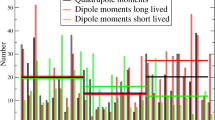Abstract.
Relativistic effects strongly influence the nuclear quadrupole coupling of atoms, molecules or solids. As first shown by Casimir in 1936, in the atomic or single-centre case, for the two states j=l±s, three radial electric-field-gradient (EFG) integrals, R ++,R +−, and R, must be introduced. The relativistic correction factors, defined for operator as
have quite different values for the three combinations. For example, for the Bi atom ground state 6p shell at Dirac-Fock(DF) level, C ++ and C +− are 1.28 and 1.91, respectively, while q −,− vanishes entirely, due to j=1/2. There also is a dependence on the n quantum number. In addition to these relativistic changes of the integrals (at the atomic centre), spin-orbit tilting effects may occur, even at light atoms, bonded to heavy ones.
We have produced DF-level, EFG integrals for the elements 1–93, investigated the hydrogen-like, n-dependent correction factors, C and used simple molecular-orbital models for estimating the spin-orbit tilting effects.
Similar content being viewed by others
Author information
Authors and Affiliations
Additional information
Received: 24 October 1996 / Accepted: 23 January 1997
Rights and permissions
About this article
Cite this article
Pyykkö, P., Seth, M. Relativistic effects in nuclear quadrupole coupling. Theor Chem Acta 96, 92–104 (1997). https://doi.org/10.1007/s002140050209
Issue Date:
DOI: https://doi.org/10.1007/s002140050209




